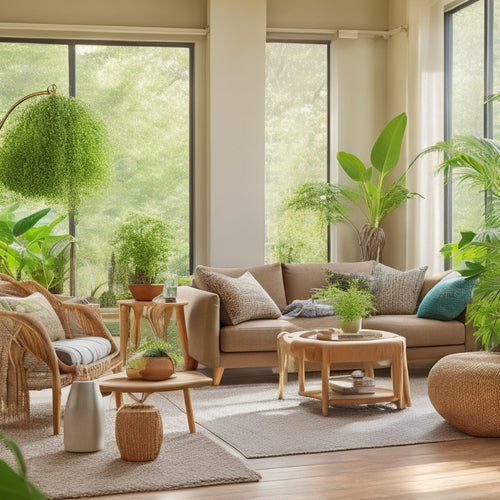Organizing With a Purpose: Eco-Friendly Solutions for Every Drawer
Share
You're taking the first step towards a more sustainable lifestyle by adopting eco-friendly solutions in your daily organizing habits. Start by decluttering with an eco-mindset, reducing waste and promoting sustainability. Opt for mindful purchasing habits, buying only what you need, and choose reusable alternatives to single-use products. Repurpose old containers, and transform them into functional organizers. Use eco-friendly storage solutions, such as bamboo bins and natural fiber baskets, to reduce plastic waste. By implementing these strategies, you'll create a more organized and sustainable space. As you refine your approach, you'll uncover more innovative ways to live greener.
Key Takeaways
• Adopt eco-friendly decluttering and mindful purchasing habits to reduce waste and promote sustainability in every drawer.
• Choose reusable, biodegradable, and recycled storage solutions like bamboo bins and natural fiber baskets to minimize waste.
• Repurpose and upcycle old containers and items to reduce waste and add a personal touch to your organized space.
• Select eco-friendly drawer liners made from sustainable materials like bamboo, cotton, or natural fibers for a stylish and functional touch.
• Maintain an eco-friendly space by simplifying storage, streamlining habits, and incorporating daily eco-habits into your routine.
Decluttering for a Greener Tomorrow
By clearing out the clutter in your home, you're not only freeing up physical space, but also reducing waste and creating an opportunity to adopt more sustainable habits.
This is where your eco-friendly journey begins. As you sort through your belongings, consider the items that can be repurposed, reused, or recycled.
This mindset shift is essential in developing green habits that benefit the environment.
By adopting an eco-motivated approach to decluttering, you'll find that it's not just about getting rid of stuff, but about making conscious choices that promote sustainability.
You'll start to think twice before buying something new, and instead, explore alternatives that reduce waste. You'll also discover the joy of repurposing items, giving old things a new life, and reducing the demand for single-use products.
As you continue on this path, you'll find that your green habits will extend beyond your home, influencing your daily choices and inspiring others to do the same.
You'll become an eco-warrior, making a positive impact on the planet, one decluttered space at a time.
Sustainable Storage Container Options
As you reimagine your storage space, you'll need containers that align with your eco-friendly values, and that's where sustainable storage container options come in - think repurposed crates, recycled plastic bins, and natural fiber baskets that replace single-use packaging.
These eco-conscious choices will help reduce waste and minimize your carbon footprint.
Consider Bamboo Bins, which aren't only stylish but also biodegradable and compostable.
For a more durable option, look into containers made from Recycled Resin, a material that reduces plastic waste and conserves natural resources.
You can also explore natural fiber baskets woven from sustainable materials like rattan, wicker, or seagrass.
These alternatives to traditional plastic containers won't only organize your space but also promote a greener lifestyle.
Repurposing Old Drawer Dividers
You can breathe new life into old drawer dividers by repurposing them into functional organizers that complement your sustainable storage solutions.
This creative revamp not only reduces waste but also adds a touch of eco-friendliness to your space.
Consider transforming old dividers into space savers, such as desk organizers or small shelves, to maximize your storage capacity.
You can also repurpose them as DIY drawer inserts, separating items like jewelry, accessories, or office supplies.
By giving old dividers a new purpose, you'll reduce the need for single-use storage solutions and contribute to a more sustainable lifestyle.
Get creative and think outside the box (or drawer!) to come up with innovative ways to repurpose old dividers.
With a little imagination, you can turn something old into something truly functional and eco-friendly.
Mindful Purchasing for Minimal Waste
As you adopt mindful purchasing habits, you'll substantially reduce waste by buying only what you need and avoiding single-use products.
You'll be surprised at how much clutter and waste you can eliminate just by being more intentional with your purchases.
Buy Only What's Needed
Your shopping habits can substantially impact the environment, with every unnecessary purchase contributing to the staggering 12.8% of global greenhouse gas emissions attributed to consumer goods. By being mindful of your purchases, you can dramatically reduce waste and minimize your ecological footprint.
To adopt a more intentional approach to shopping, consider the following principles:
| Essential Shopping | Intentional Purchases | Waste Reduction |
| Need-based buying | Avoid impulse buys | Reduces unnecessary items |
| Buying in bulk | Plans purchases in advance | Reduces packaging waste |
| Swapping single-use items | Chooses reusable alternatives | Reduces single-use waste |
| Buying second-hand | Extends product lifespan | Reduces waste and emissions |
Avoid Single-Use Products
By opting for reusable alternatives, individuals can substantially reduce their reliance on single-use products, which account for a substantial portion of the staggering 12.8% of global greenhouse gas emissions attributed to consumer goods.
You can start by saying goodbye to single-use bags and hello to reusable totes or cloth bags. Refuse bags, and instead, choose reusable produce bags for your grocery shopping.
When it comes to personal care, ditch the face wash containing microbeads and opt for natural exfoliants like sugar or salt. Microbeads, often found in face wash and toothpaste, can harm aquatic life and contaminate our waterways.
When shopping, choose products with minimal or biodegradable packaging. Avoid buying items individually wrapped, and instead, opt for bulk purchases.
DIY Drawer Organizer Hacks
As you start organizing your drawers, you'll realize that you don't need to buy new containers or dividers.
You can repurpose old containers like mason jars, cardboard boxes, or even old t-shirts to create unique and functional storage solutions.
Repurpose Old Containers
Transforming old containers into functional organizers is a creative way to declutter your drawers while reducing waste. You can give new life to items you might've otherwise thrown away, making it a win-win for the environment and your storage needs.
Start by collecting various containers like old mason jars, wooden crates, or plastic bins. Clean and dry them thoroughly to prepare them for their new purpose.
Get creative with your container revamp by adding labels, paint, or decorative stickers to personalize your organizers. You can use them to store small items like buttons, safety pins, or beads in your sewing drawer or to organize office supplies like paper clips, rubber bands, or pushpins.
Think beyond traditional storage and use old containers as drawer dividers or separators. For instance, a small wooden crate can separate your kitchen utensils from your cooking spices, keeping your drawers organized and easy to navigate.
Upcycled Drawer Dividers
You can take your repurposing skills to the next level by creating upcycled drawer dividers that maximize storage space and add a personal touch to your organization system.
By thinking outside the box, you can transform old materials into functional and eco-friendly dividers that bring a touch of vintage charm to your drawers.
Get creative with materials like cardboard tubes, old folders, or even vintage postcards.
Cut them into desired shapes and sizes, then decorate with paint, stickers, or decoupage to give them a personalized look.
You can also repurpose old CDs, DVDs, or vinyl records as dividers, adding a unique touch to your drawer organization.
With upcycled drawer dividers, you're not only reducing waste but also infusing your space with a sense of history and character.
By embracing creative repurposing, you'll be amazed at how easily you can create functional and stylish dividers that not only organize your belongings but also tell a story.
Eco-Friendly Drawer Liner Alternatives
Your search for eco-friendly drawer liner alternatives ends with reusable cloth drawer liners, which offer a sustainable substitute to traditional paper or plastic liners. These eco-friendly options not only reduce waste but also provide a stylish and functional way to organize your drawers.
Bamboo Liners: Made from natural bamboo, these liners are biodegradable, compostable, and gentle on the environment.
Cotton Drawer Liners: Reusable cotton liners are a great alternative to paper or plastic liners, and they can be easily washed and reused multiple times.
Natural Fiber Liners: Made from natural materials like hemp or jute, these liners are durable, sustainable, and add a touch of natural elegance to your drawers.
Upcycling Old Drawer Contents
Give old drawer contents a new lease on life by repurposing them into functional items that reduce waste and spark creativity.
You'll be amazed at how forgotten treasures can be transformed into unique and useful items. Through creative reuse, you can breathe new life into old, discarded items, reducing the need for new, resource-intensive products.
Start by rummaging through your drawers and gathering items you no longer need or use.
Consider turning old t-shirts into reusable bags, transforming broken jewelry into quirky decorations, or upcycling cardboard tubes into desk organizers. Get creative and think outside the box!
With a little imagination, you can turn trash into treasure, reducing waste and conserving natural resources.
Drawer Organization for Zero Waste
As you tackle your drawer organization for zero waste, you're not just decluttering your space - you're also contributing to a more sustainable lifestyle.
By clearing out unnecessary items, you're reducing waste and making room for eco-friendly storage options that align with your values.
Now, let's explore how to put these principles into practice, starting with decluttering for a cause and finding storage solutions that are gentle on the planet.
Decluttering for a Cause
By adopting a mindful approach to decluttering, you can transform your drawers into a haven of sustainability, where every item has a purpose and waste is a relic of the past.
As you sort through your belongings, remember that every item you remove can make a difference in someone's life.
Partner with local charities: Research organizations that accept gently used items and partner with them to host donation drives or collection events.
Organize community outreach programs: Collaborate with community centers, schools, or places of worship to host workshops or events that promote sustainable living and zero waste practices.
Donate to those in need: Identify local families or individuals in need and donate items that can make a tangible difference in their lives, such as clothing, household items, or furniture.
Eco-Friendly Storage Options
Your newly decluttered space is now ready for eco-friendly storage solutions that maintain your commitment to zero waste, and you can start by repurposing items you already own or finding sustainable alternatives.
Think beyond traditional plastic storage bins and opt for reusable baskets made from biodegradable materials like bamboo, wicker, or recycled paper. These eco-friendly options not only reduce waste but also add a touch of natural charm to your space.
When selecting storage solutions, prioritize durability and versatility.
Look for products made from sustainable resources, such as recycled cardboard or repurposed fabric scraps.
You can also upcycle old containers, like mason jars or cardboard tubes, to create unique and functional storage units.
The Power of Edit and Refine
Editing and refining your eco-friendly solutions is essential to their overall effectiveness, as it allows you to streamline your strategies and eliminate any unnecessary steps. This process is vital in achieving Curated Minimalism, where every item serves a purpose and contributes to a more intentional living space.
As you refine your eco-friendly solutions, consider the following key areas to focus on:
-
Simplify your storage: Identify the essential items you need to store and eliminate any unnecessary containers or storage solutions.
-
Streamline your habits: Analyze your daily habits and eliminate any unnecessary steps or tasks that can be simplified or automated.
-
Optimize your space: Assess your living space and eliminate any clutter or unnecessary items that don't contribute to your intentional living goals.
Maintaining Your Eco-Friendly Space
Having refined your eco-friendly solutions, it's now time to focus on maintaining your space, ensuring that your intentional living goals remain on track. To do this, you'll need to incorporate eco habits into your daily routines. This might seem challenging, but with a few simple adjustments, you can turn your eco-friendly space into a sustainable haven.
Here are some daily habits to get you started:
| Habit | Description | Frequency |
|---|---|---|
| Morning tidy | Take 10 minutes to tidy up your living space | Daily |
| Recycling routine | Set aside 30 minutes to sort and recycle | Weekly |
| Meal prep | Plan and prepare eco-friendly meals | 3 times a week |
| Composting | Add food waste to your compost bin | Daily |
| Mindful consumption | Take a moment to reflect on your consumption habits | Daily |
Frequently Asked Questions
Can I Reuse Old Cardboard Boxes as Drawer Dividers?
You can breathe new life into old cardboard boxes by repurposing them as drawer dividers, creating unique Cardboard Creations through a Box Revival, giving your space a personalized touch while reducing waste.
How Often Should I Clean and Maintain My Organized Drawers?
You should maintain your organized drawers with daily habits like tidying up clutter and seasonal refreshes every 3-4 months to keep your space organized and guarantee your eco-friendly efforts remain effective.
Are Bamboo Drawer Organizers More Eco-Friendly Than Wooden Ones?
You're wondering if bamboo drawer organizers are more eco-friendly than wooden ones. The answer is yes, as bamboo has a lower carbon footprint and is a highly sustainable material, making it a guilt-free choice for your organized space.
Can I Use Old Mason Jars to Store Small Items in My Drawers?
You can repurpose old mason jars to store small items in your drawers, adding a touch of Mason Jar Decor. Simply label them with Jar Labeling Tips, and you'll have a charming, eco-friendly storage solution that's both functional and visually appealing.
Will an Eco-Friendly Drawer Organization System Increase My Home's Value?
When you invest in an eco-friendly drawer organization system, you'll likely see an appraisal boost, giving you a resale advantage, as it showcases your home's commitment to sustainability, appealing to eco-conscious buyers.
Related Posts
-

Evaluating Solar Power Options for Businesses
Evaluating solar power options for your business can greatly reduce energy costs and enhance sustainability. Start by...
-

Eco-Friendly Home Design Ideas for Beginners
If you're starting your eco-friendly home design expedition, focus on sustainable materials like recycled wood or rec...
-

High-Performance Solar Solutions for Sustainable Living
High-performance solar solutions are your gateway to sustainable living, maximizing energy efficiency while considera...


